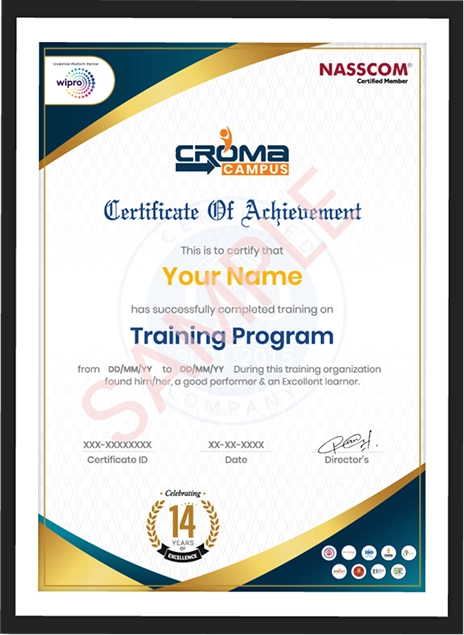- 2 Live Project
- Self-Paced/ Classroom
- Certification Pass Guaranteed
Course Offered By
Linux online training in India helps to learn all the basic testing concepts and methods.
You can learn to employ a language and how to communicate with other professionals.
Linux online Certification courses helps to learn about the principles and practices for problem solving, delivery, workflow and more.
You will develop an understanding to test concepts, testing approaches, testing principles, and objectives.
You can analyse functional and non-functional specifications.
We are the leading training provider and you will learn to use various testing tools and to select them.
We prepare you for Linux certification exam at various levels.
You can learn best testing practices and methods for the workplace.
We are a leading Linux online training in India that helps you to get expertise in using various testing tools.
With the certification course you can learn to analyse data, interpret data and make reports.
It will give your resume a little more strength and make progress in your career.
Analysts are important assets for many organizations.
You must have the understanding to analyse data and reporting.
Know to interact with fellow professionals for successful implementation of various campaigns.
You must know about Red hat for the role of Linux administrator.
Must develop an understanding of Linux trends and technologies.
You have the understanding of Linux operating system.
You must know about installing of CentOS 7 Linux, managing files, Access CLI and getting help.
You must know to view, create and edit text files from command line.
Also, must have understanding about managing local Linux users, permissions and groups.
Access Linux file systems and configure virtualized system.
Also, you must be able to configure networking, archive files and configure package manager.
we train you to get hired.
we train you to get hired.
By registering here, I agree to Croma Campus Terms & Conditions and Privacy Policy
Red Hat System Administration I
Red Hat System Administration II
Red Hat Linux Automation with Ansible
Describe and define open source, Linux distributions, and Red Hat Enter prise Linux.
Log into a Linux system and run simple commands using the shell.
Copy, move, create, delete, and organize files while working from the bash shell.
Resolve problems by using local help systems.
Manage text files from command output or in a text editor.
Create, manage, and delete local users and groups, as well as administer local password policies.
Set Linux file system permissions on files and interpret the security effects
of different permission settings.
Evaluate and control processes running on a Red Hat Enterprise Linux system.
Control and monitor network services and system daemons using systemd.
Configure secure command line service on remote systems, using OpenSSH.
Locate and accurately interpret logs of system events for troubleshooting purposes.
Configure network interfaces and settings on Red Hat Enterprise Linux servers.
Download, install, update, and manage software packages from Red Hat and yum package repositories.
Access, inspect, and use existing file systems on storage attached to a Linux server.
Investigate and resolve issues in the web-based management interface, getting support from Red Hat to help solve problems.
Run commands more efficiently by using advanced features of the Bash shell, shell scripts, and various utilities provided by Red Hat Enterprise Linux.
Schedule commands to run in the future, either one time or on a repeating schedule.
Improve system performance by setting tuning parameters and adjusting scheduling priority of processes.
Interpret and set access control lists (ACLs) on files to handle situations requiring complex user and group access permissions.
Protect and manage the security of a server by using SE Linux.
Create and manage storage devices, partitions, file systems, and swap spaces from the command line.
Create and manage logical volumes containing file systems and swap spaces from the command line.
Manage storage using the Straits local storage management system and use VDO volumes to optimize storage space in use.
Use the NFS protocol to administer network-attached storage.
Manage the boot process to control services offered and to troubleshoot and repair problems.
Control network connections to services using the system firewall and SE Linux rules.
Install Red Hat Enterprise Linux on servers and virtual machines.
Obtain, run, and manage simple, lightweight services as containers on a single Red Hat Enterprise Linux server.
Describe Ansible concepts and install Red Hat Ansible Engine.
Configure Ansible to manage hosts and run ad hoc Ansible commands.
Write a simple Ansible Playbook and run it to automate tasks on multiple managed hosts.
Write playbooks that use variables to simplify management of the play book and facts to reference information about managed hosts.
Manage task control, handlers, and task errors in Ansible Playbooks.
Deploy, manage, and adjust files on hosts managed by Ansible.
Write playbooks that are optimized for larger, more complex projects.
Use Ansible roles to develop playbooks more quickly and to reuse Ansible code.
Troubleshoot playbooks and managed hosts.
Automate common Linux system administration tasks with Ansible.
Red Hat System Administration I
Red Hat System Administration II
Describe and define open source, Linux distributions, and Red Hat Enter prise Linux.
Log into a Linux system and run simple commands using the shell.
Copy, move, create, delete, and organize files while working from the bash shell.
Resolve problems by using local help systems.
Manage text files from command output or in a text editor.
Create, manage, and delete local users and groups, as well as administer local password policies.
Set Linux file system permissions on files and interpret the security effects of different permission settings.
Evaluate and control processes running on a Red Hat Enterprise Linux system.
Control and monitor network services and system daemons using systemd.
Configure secure command line service on remote systems, using OpenSSH.
Locate and accurately interpret logs of system events for troubleshooting purposes.
Configure network interfaces and settings on Red Hat Enterprise Linux servers.
Install and update software
Download, install, update, and manage software packages from Red Hat and yum package repositories.
Access, inspect, and use existing file systems on storage attached to a Linux server.
Investigate and resolve issues in the web-based management interface, getting support from Red Hat to help solve problems.
Run commands more efficiently by using advanced features of the Bash shell, shell scripts, and various utilities provided by Red Hat Enterprise Linux.
Schedule commands to run in the future, either one time or on a repeating schedule.
Improve system performance by setting tuning parameters and adjusting scheduling priority of processes.
Interpret and set access control lists (ACLs) on files to handle situations requiring complex user and group access permissions.
Protect and manage the security of a server by using SE Linux.
Create and manage storage devices, partitions, file systems, and swap spaces from the command line.
Create and manage logical volumes containing file systems and swap spaces from the command line.
Manage storage using the Straits local storage management system and use VDO volumes to optimize storage space in use.
Use the NFS protocol to administer network-attached storage.
Manage the boot process to control services offered and to troubleshoot and repair problems.
Control network connections to services using the system firewall and SE Linux rules.
Install Red Hat Enterprise Linux on servers and virtual machines.
Obtain, run, and manage simple, lightweight services as containers on a single Red Hat Enterprise Linux server.
we train you to get hired.
Phone (For Voice Call):
+91-971 152 6942WhatsApp (For Call & Chat):
+919711526942Stories
success
inspiration
career upgrade
career upgrade
career upgrade
career upgrade
You will get certificate after
completion of program
You will get certificate after
completion of program
You will get certificate after
completion of program
in Collaboration with

Empowering Learning Through Real Experiences and Innovation
we train you to get hired.
Phone (For Voice Call):
+91-971 152 6942WhatsApp (For Call & Chat):
+919711526942Get a peek through the entire curriculum designed that ensures Placement Guidance
Course Design By
Course Offered By
Ready to streamline Your Process? Submit Your batch request today!
Linux online training in India is a course that teaches individuals how to use and administer the Linux operating system.
To take Linux online training in India, you should have basic knowledge of computer systems and networks.
The duration of Linux online training in India usually takes around 30-40 hours to complete the course.
After completing Linux online training in India, you can work as a Linux administrator, system engineer, network engineer, or freelancer.
Highest Salary Offered
Average Salary Hike
Placed in MNC’s
Year’s in Training

fast-tracked into managerial careers.
Get inspired by their progress in the
Career Growth Report.
FOR QUERIES, FEEDBACK OR ASSISTANCE
Best of support with us
For Voice Call
+91-971 152 6942For Whatsapp Call & Chat
+91-9711526942





















